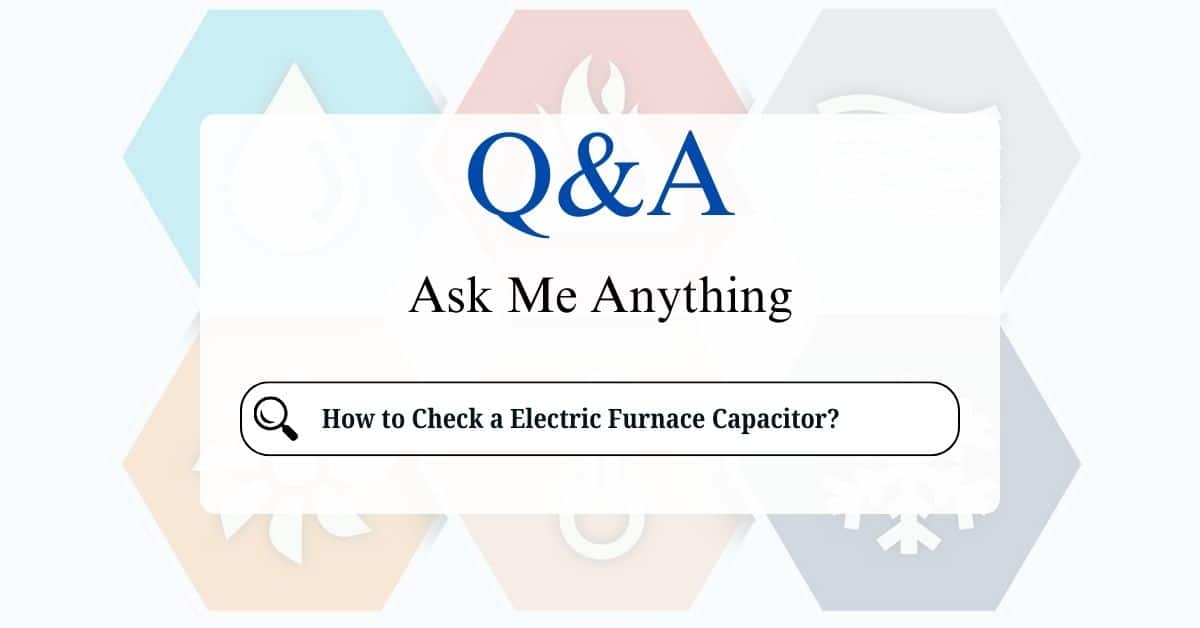Electric furnaces rely on several key components to keep your home warm, and the capacitor is one of them. Capacitors are like small batteries that provide the initial surge of power needed to start motors, such as the blower motor. If a capacitor fails, your furnace might not start or run properly. This friendly guide will explain what capacitors do, how to recognize potential problems, and how to carefully test them.
What is a Capacitor and What Does It Do in a Furnace?
Capacitors store electrical energy and release it quickly to give motors a boost. In an electric furnace, they’re primarily used for:
- Starting the Blower Motor: The blower motor circulates heated air throughout your home. It needs a strong initial jolt of power to start, and the capacitor provides this.
Signs of a Bad Capacitor in Your Electric Furnace
A failing capacitor can cause several noticeable issues:
- Furnace Not Starting: This is the most common symptom. If your furnace doesn’t turn on at all when you turn up the thermostat, a bad capacitor is a likely culprit.
- Humming Noise: You might hear a humming noise coming from the furnace, indicating that the motor is trying to start but can’t get enough power.
- Blower Motor Starts Slowly or Not at All: If the blower motor starts very slowly or doesn’t spin at all, a bad capacitor could be the cause.
- Furnace Starts and Then Shuts Off Quickly: In some cases, the furnace might start briefly and then shut off shortly after, suggesting a weak capacitor.
Crucial Safety Precautions Before Testing:
- Turn Off the Power: Absolutely essential. Before working on any electrical components, turn off the power to the furnace at the circuit breaker in your electrical panel. This is vital to prevent electric shock.
- Discharge the Capacitor: Capacitors store electrical charge even after the power is turned off. You must discharge the capacitor before handling it.
How to Discharge a Capacitor (from Furnace
There are two main methods:
- Using a Screwdriver (Less Recommended): Use a screwdriver with an insulated handle to carefully short the terminals of the capacitor. You might see a small spark. Repeat this a couple of times to ensure it’s fully discharged. This method carries a higher risk of damage to the capacitor or injury if not done correctly.
- Using a Resistor (Recommended): A safer method involves using a resistor (around 20,000 ohms, 5 watts). Connect the resistor’s leads to the capacitor terminals. This will slowly discharge the capacitor without the risk of a spark.
How to Test a Capacitor
There are two main ways to test a capacitor:
- Visual Inspection:
- Look for Bulging or Leaking: A physically damaged capacitor, with a bulging top or leaking fluid, is definitely bad and needs replacement.
- Using a Multimeter (Recommended for Accurate Testing):
- Set the Multimeter: Set your multimeter to measure capacitance (usually marked with a “µF” or “nF”).
- Connect the Probes: Connect the multimeter probes to the capacitor terminals.
- Compare the Reading: Compare the reading on the multimeter to the capacitor’s rated capacitance (printed on the capacitor). A reading that is significantly lower (more than 10% below the rated value) indicates a weak or failing capacitor.
Replacing a Capacitor
If your testing reveals a bad capacitor, you’ll need to replace it.
- Get the Correct Replacement: Make sure you get a replacement capacitor with the same capacitance (µF) and voltage rating as the original. These values are printed on the capacitor itself.
- Discharge the Old Capacitor (Again!): Even if you’ve already discharged it, discharge it again before removing it.
- Take a Picture of the Wiring: Before disconnecting the wires, take a picture or make a diagram of how they are connected. This will help you reconnect them correctly to the new capacitor.
- Connect the New Capacitor: Connect the wires to the new capacitor according to your picture or diagram.
- Restore Power and Test: Turn the power back on at the circuit breaker and test your furnace.
When to Call a Professional
- Uncomfortable with Electrical Work: If you’re not comfortable working with electrical components, it’s always best to call a qualified HVAC technician.
- Unable to Discharge the Capacitor Safely: If you are unsure about how to safely discharge the capacitor, do not attempt to test it yourself. Contact a professional.
- Problem Persists After Replacing the Capacitor: If you replace the capacitor and the problem still persists, there may be another issue with your furnace that requires professional diagnosis.
Testing a capacitor can be a useful troubleshooting step, but safety is paramount. Always turn off the power and properly discharge the capacitor before handling it. If you’re unsure about any part of the process, it’s always best to call a qualified HVAC technician. They have the training, tools, and experience to handle electrical repairs safely and effectively.






